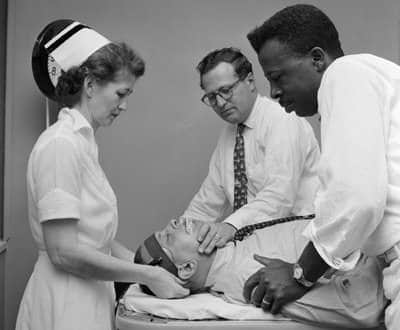Electroconvulsive therapy (ECT) is routinely used to treat refractory depression and catatonia, especially in the elderly where pharmacotherapy could result in undesirable side effects. Essentially, it involves jolting the brain to create a controlled clonic seizure – the patient loses consciousness, has convulsions, and cannot recollect the procedure. I had the opportunity to witness ECT first hand this morning with a group of my colleagues.
The attending physician was kind  enough to walk us through a typical preparation. After receiving the patient’s informed consent, methohexital (a very short acting barbiturate) induces anesthesia and succinylcholine (a depolarizing neuromuscular junction blocker) globally relaxes muscular tone. These meds minimally affect a patient’s seizure threshold and are consequently good options. Sometimes patients are given caffeine to help them have a “better” seizure too. Electrodes then transmit the electric pulse to generate the seizure. Patients naturally wake themselves up due to the short half-life of the anesthetic. The overall procedure (assuming no complications) takes 5-10 minutes once the patient is prepped.
enough to walk us through a typical preparation. After receiving the patient’s informed consent, methohexital (a very short acting barbiturate) induces anesthesia and succinylcholine (a depolarizing neuromuscular junction blocker) globally relaxes muscular tone. These meds minimally affect a patient’s seizure threshold and are consequently good options. Sometimes patients are given caffeine to help them have a “better” seizure too. Electrodes then transmit the electric pulse to generate the seizure. Patients naturally wake themselves up due to the short half-life of the anesthetic. The overall procedure (assuming no complications) takes 5-10 minutes once the patient is prepped.
So how does jolting the brain help with depression? Frankly, scientists aren’t sure what the exact mechanism is, but it may deal with increased hippocampal neurogenesis – an outcome which is documented in murine cohorts receiving electroshock therapy. I guess it’s just another one of those things in medicine that we don’t understand but continue to use because it works. 🙂






My father, a man I admire to probably the greatest degree of any I have known required this intervention on a number of occasions in the 50’s and early 60’s. It was wonderfully effective.
All they had to treat BPD at that time was Thorazine, Not even Lithium at that time. He tragically took his own life but the ECT gave him another chance to live long enough to live long enough until effective drug therapies were discovered.
I often think the Movie, and Popular Book: One Flew Over the Cuckoo’s Nest ” did grevious harm to ECT and Psychatric care in general in the perception of the general population.
How many patient’s have been denied this intervention by the widespread prejudice against this treatment when they have failed medication. I am sure many lives have been lost.
Perhaps you will be the one to corroborate my impression an spread it to the popular press to get this corrected.
Thank you for sharing your family’s experience with this wonderful technique, Michael! It pains me to hear about your father’s passing, but it goes to show how procedures like ECT can prolong lives when pharmacotherapy cannot.
Wow! That’s really interesting. I never knew that was how EST worked. I guess I always pictured the Hollywood depiction of people getting their brains fried to mush. 😛